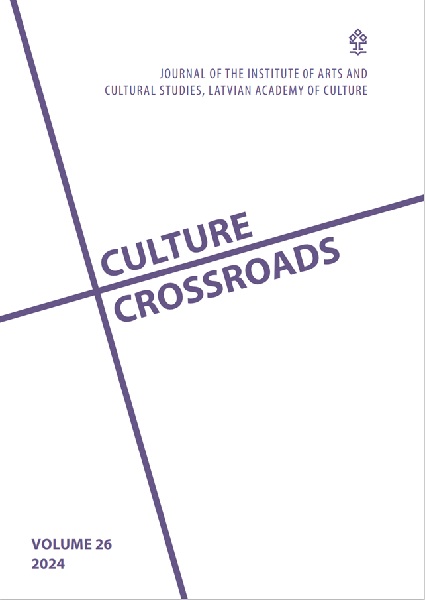VISUAL AND VERBAL REPRESENTATION OF THE PLAY METAPHOR IN LATVIAN POLITICAL CARTOONS
DOI:
https://doi.org/10.55877/cc.vol26.498Keywords:
conceptual metaphor, cognitive linguistics, cognitive stylistics, game categories, visual representationAbstract
The article’s theoretical framework is set in cognitive linguistics and stylistics. It explores the progressing domain of metaphor research, which has expanded substantially since the 1970s, notably in investigating visual and multimodal metaphors in the last twenty years.
The article aims to study the visual and verbal representation of the PLAY metaphor in Latvian political cartoons, applying conceptual metaphor theory. The need for this study arises from the limited understanding of the metaphorical thought of PLAY in the Latvian language and culture.
The main research question studies the formation of the PLAY metaphor by distinguishing the conceptual mappings of game categories described by Roger Caillois – Agon, Alea, and Mimicry.
The metaphor identification procedure of four stages – recognition, verification, comprehension, and interpretation – proposed by Anita Naciscione in 2001, is applied in case studies.
The main findings highlight the cultural significance of the PLAY metaphor in Latvian thought, language and culture. The main conclusions demonstrate that every type of game category forms a distinct group of conceptual mappings, illustrating the sustainable nature of the metaphorical thought of PLAY. The original contribution of this study lies in its comprehensive analysis of the PLAY metaphor, providing insights into metaphorical thought in human perception and understanding in cognitive linguistics.
Downloads
References
Aristotle (2007). On Rhetoric: A Theory of Civic Discourse. Second ed. Translated with Introduction, Notes, and Appendices by G. A. Kennedy. New York; Oxford: Oxford University Press.
Arnheim, R. (2004a). Art and Visual Perception: A Psychology of the Creative Eye. 50th Anniversary ed. Berkeley; Los Angeles; London: University of California Press.
Arnheim, R. (2004b). Visual Thinking. 35th Anniversary ed. Berkeley; Los Angeles; London: University of California Press.
Arnheim, R. (2009). The Power of the Center: A Study of Composition in the Visual Arts. 20th Anniversary ed. Berkeley; Los Angeles; London: University of California Press.
Burvis, I. (2010). Pretruna..? Blefs..? Politiska spēle..? Diena, 05.05.2010. Available: http://www.diena.lv/blogi/pretruna-blefs-politiska-spele-731427 (viewed 29.12.2010.)
Caillois, R. (2001). Man, Play, and Games. Chicago: University of Illinois Press.
Forceville, Ch. ([1996] 2002). Pictorial Metaphor in Advertising. London; New York: Routledge.
Forceville, Ch. J., Urios-Aparisi, E. (eds) (2009). Multimodal Metaphor. Berlin; New York: Mouton de Gruyter.
Forceville, Ch. (2020). Visual and Multimodal Communication: Applying the Relevance Principle. New York: Oxford University Press.
Gibbs, R. W. Jr. ([1994] 2002). The Poetics of Mind: Figurative Thought, Language and Understanding. Cambridge: Cambridge University Press.
Gibbs, R. W. Jr. (ed.) (2016). Mixing Metaphor. Amsterdam; Philadelphia: John Benjamins Publishing Company.
Gibbs, R. W. Jr. (2017). Metaphor Wars: Conceptual Metaphors in Human Life. New York: Cambridge University Press.
Huizinga, J. ([1949] 1980). Homo Ludens: A Study of the Playelement in Culture. London; Boston; Henley: Routledge and Kegan Paul.
Knieper, T. (2023, June 9). Political Cartoon. Encyclopedia Britannica. Available: https://www.britannica.com/topic/political-cartoon (viewed 18.02.2024.)
Kövecses, Z. (2005). Metaphor in Culture: Universality and Variation. Cambridge; New York: Cambridge University Press.
Kövecses, Z. (2020). Extended Conceptual Metaphor Theory. Cambridge; New York: Cambridge University Press.
Kress, G., van Leeuwen, T. (2020). Reading Images: The Grammar of Visual Design. Third ed. London; New York: Routledge.
Lakoff, G., Johnson, M. ([1980] 2003). Metaphors We Live By. With a New Afterword. Chicago; London: The University of Chicago Press.
Leech, G. N. (1969). A Linguistic Guide to English Poetry. New York: Longman.
Naciscione, A. (2001). Phraseological Units in Discourse: Towards Applied Stylistics. Riga: Latvian Academy of Culture.
Naciscione, A. (2010). Stylistic Use of Phraseological Units in Discourse. Amsterdam; Philadelphia: John Benjamins Publishing Company.
Naciscione, A. (2016). Extended Metaphor in the Web of Discourse. In: R. W. Jr. Gibbs (ed.). Mixing Metaphor. Amsterdam; Philadelphia: John Benjamins Publishing Company, pp. 241–266.
Ošs, Ē. (2011a). Varoņu maiņa [Changing the Protagonist]. Latvijas Avīze, 02.05.2011. Available: http://la.lv/index.phpoption=com_avizecaricature&id=539§ionId=40&Itemid=287#239 (viewed 10.12.2011.)
Ošs, Ē. (2011b). Brīnumrats [Wheel of Fortune]. Latvijas Avīze, 16.09.2011. Available: http://la.lv/index.phpoption=com_avizecaricature&id=430§ionId=40&tagId=2734&Itemid=287 (viewed 28.12.2011.)
Pragglejaz Group (2007). MIP: A Method for Identifying Metaphorically Used Words in Discourse. Metaphor and Symbol, No. 22 (1), pp. 1–39.
Steen, G. J., Dorst, A. G., Herrmann, B., Kaal, A. A., Krennmayr, T., Pasma, T. (2010). A Method for Linguistic Metaphor Identification: From MIP to MIPVU. Amsterdam; Philadelphia: John Benjamins Publishing Company.
Steen, G. (ed.) (2018). Visual Metaphor: Structure and Process. Amsterdam; Philadelphia: John Benjamins Publishing Company.
Šļūka, G. (2010a). Uz vēlēšanām [To the Elections]. Latvijas Avīze, 2. okt., p. 1.
Šļūka, G. (2010b). Karikatūra.lv. Available: https://karikatura.lv (viewed 1.08.2018.)
Wales, K. (2011). A Dictionary of Stylistics. Third ed. London; New York: Routledge.
Downloads
Published
Issue
Section
License
Copyright (c) 2025 Culture Crossroads

This work is licensed under a Creative Commons Attribution 4.0 International License.


